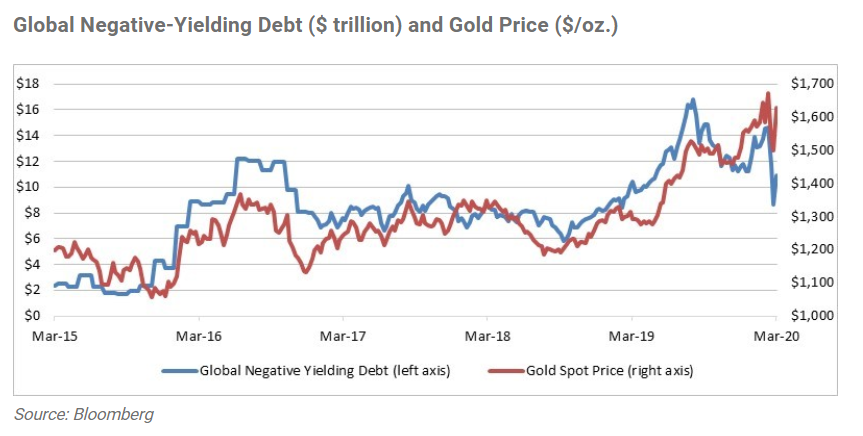As a result of gold’s rarity and sturdiness, which makes it priceless and appropriate for long-term storage, funding in gold has an extended historical past. In keeping with the Nationwide Mining Affiliation, gold was first employed many millennia in the past in Japanese Europe to embellish objects; subsequently, its use grew to become widespread in jewellery. Gold has additionally been used as a medium of change for worldwide commerce, and the U.S. used the gold commonplace to worth currencies till 1971. At this time, our query is, given current inventory market volatility, ought to traders take into account including gold to their portfolios?
Provide and Demand
As with monetary belongings, reminiscent of shares and bonds, the worth of gold is influenced by provide and demand. Mine manufacturing and recycling are the 2 sources of gold provide. The jewellery business represents the most important supply of demand for gold, with China and India being the 2 largest customers of gold jewellery. Funding in gold, by way of choices reminiscent of bullion, cash, and ETFs that retailer gold bullion, is the second-largest supply of demand. Central banks that personal gold as a reserve asset are additionally a major supply of demand.
Industrial makes use of for gold, reminiscent of electronics manufacturing, signify lower than 10 p.c of demand for this metallic. Silver and different commodities are in increased demand for industrial functions. As a result of funding represents a big portion of gold demand, gold costs have a tendency to carry up throughout a slowing economic system or inventory market decline.
Gold Costs
Gold costs are delicate to macroeconomic elements and financial coverage, together with forex change charges, central financial institution insurance policies, rates of interest, and inflation. The Fed’s rate of interest coverage and the change fee of the U.S. greenback, for instance, affect gold costs. These complicated elements make it tough to forecast gold costs.
Curiosity Charges
Lately, there was a powerful relationship between actual rates of interest and gold costs. An actual rate of interest adjusts for inflation by measuring the distinction between the nominal rate of interest and inflation. (The nominal rate of interest refers back to the acknowledged rate of interest on a mortgage, regardless of charges or curiosity.) The chart under illustrates the historic relationship between gold costs and actual rates of interest utilizing the true yield (yield above inflation) of 10-year U.S. Treasury inflation-protected securities (TIPS) because the benchmark. TIPS bonds are listed to inflation, have U.S. authorities backing, and pay traders a set rate of interest. Their principal worth adjusts up and down primarily based on the inflation fee. As you’ll be able to see, actual rates of interest and gold costs have typically exhibited an inverse relationship.

This relationship can be seen within the chart under, which reveals the shut hyperlink between gold costs and the worth of bonds which have a unfavorable yield. Each charts illustrate the rising attraction to traders of gold when actual rates of interest are low or unfavorable. Conversely, time intervals with increased actual rates of interest are usually much less favorable for gold, as gold produces no earnings for traders. The present market setting of low actual rates of interest is definitely a constructive that will sign elevated curiosity in gold on the a part of traders.

Gold as an Funding
As with low or unfavorable actual rates of interest, funding in gold can function a safe-harbor funding for traders during times of heightened financial or geopolitical misery. At the moment, gold costs are close to a seven-year excessive on account of current market volatility and sharp decline in rates of interest. As measured by portfolio efficiency, gold has a low correlation with different asset lessons. Throughout a while intervals, it could enhance in worth, whereas different investments fall in worth.
Dangers to Watch For
Buyers ought to preserve an eye fixed out for market environments which might be unfavorable for gold costs. As an illustration, a constructive outlook on financial progress and a rise in actual rates of interest would current a poor outlook for gold. Moreover, gold is tough to worth, provided that this funding has no money circulate or earnings metrics to measure. Lastly, gold costs are risky. Throughout some historic intervals, the worth of gold has demonstrated comparable volatility to that of the S&P 500. Subsequently, given gold’s volatility and lack of earnings stream, gold will not be applicable for extra conservative traders in want of earnings.
Funding Outlook
Though the gold markets are topic to hypothesis and volatility, the prospects for gold costs at the moment seem favorable, primarily based on financial progress considerations because of the unfold of the coronavirus, low actual rates of interest, and up to date market volatility. Though previous efficiency isn’t any assure of future outcomes, gold costs peaked round $1,900 per ounce in September 2011. There’s no technique to know for certain the place the markets will go, however the present financial turmoil suggests the likelihood that we’ll see increased gold costs.
Investments are topic to danger, together with lack of principal. The dear metals, uncommon coin, and uncommon forex markets are speculative, unregulated, and risky, and costs for these things might rise or fall over time. These investments will not be appropriate for all traders, and there’s no assure that any funding will be capable to promote for a revenue sooner or later.
Editor’s Notice: The authentic model of this text appeared on the Impartial
Market Observer.

